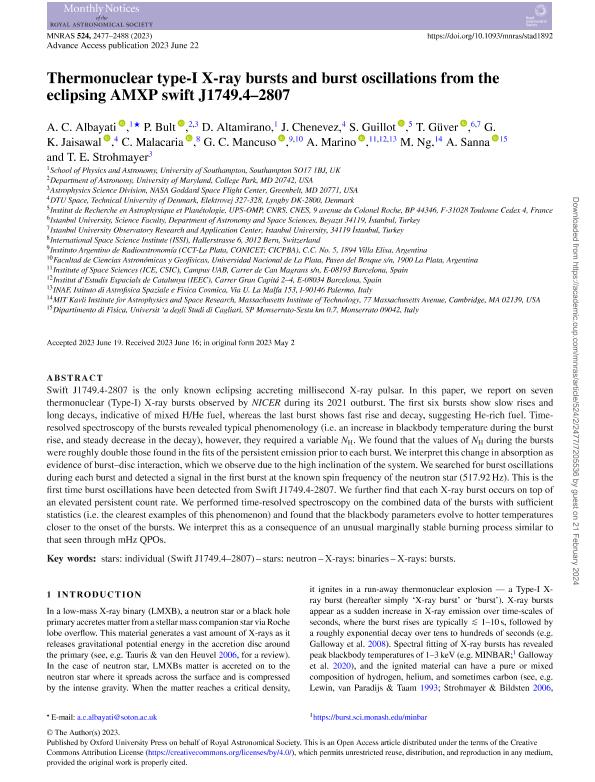Mostrar el registro sencillo del ítem
dc.contributor.author
Albayati, A. C.
dc.contributor.author
Bult, P.
dc.contributor.author
Altamirano, D.
dc.contributor.author
Chenevez, J.
dc.contributor.author
Guillot, S.
dc.contributor.author
Güver, T.
dc.contributor.author
Jaisawal, G. K.
dc.contributor.author
Malacaria, C.
dc.contributor.author
Mancuso, Giulio Cesare

dc.contributor.author
Marino, A.
dc.contributor.author
Ng, M.
dc.contributor.author
Sanna, A.
dc.contributor.author
Strohmayer, T. E.
dc.date.available
2024-02-28T16:12:39Z
dc.date.issued
2023-09
dc.identifier.citation
Albayati, A. C.; Bult, P.; Altamirano, D.; Chenevez, J.; Guillot, S.; et al.; Thermonuclear type-I X-ray bursts and burst oscillations from the eclipsing AMXP swift J1749.4-2807; Wiley Blackwell Publishing, Inc; Monthly Notices of the Royal Astronomical Society; 524; 2; 9-2023; 2477-2488
dc.identifier.issn
0035-8711
dc.identifier.uri
http://hdl.handle.net/11336/228858
dc.description.abstract
Swift J1749.4-2807 is the only known eclipsing accreting millisecond X-ray pulsar. In this paper, we report on seven thermonuclear (Type-I) X-ray bursts observed by NICER during its 2021 outburst. The first six bursts show slow rises and long decays, indicative of mixed H/He fuel, whereas the last burst shows fast rise and decay, suggesting He-rich fuel. Time-resolved spectroscopy of the bursts revealed typical phenomenology (i.e. an increase in blackbody temperature during the burst rise, and steady decrease in the decay), however, they required a variable NH. We found that the values of NH during the bursts were roughly double those found in the fits of the persistent emission prior to each burst. We interpret this change in absorption as evidence of burst-disc interaction, which we observe due to the high inclination of the system. We searched for burst oscillations during each burst and detected a signal in the first burst at the known spin frequency of the neutron star (517.92 Hz). This is the first time burst oscillations have been detected from Swift J1749.4-2807. We further find that each X-ray burst occurs on top of an elevated persistent count rate. We performed time-resolved spectroscopy on the combined data of the bursts with sufficient statistics (i.e. the clearest examples of this phenomenon) and found that the blackbody parameters evolve to hotter temperatures closer to the onset of the bursts. We interpret this as a consequence of an unusual marginally stable burning process similar to that seen through mHz QPOs.
dc.format
application/pdf
dc.language.iso
eng
dc.publisher
Wiley Blackwell Publishing, Inc

dc.rights
info:eu-repo/semantics/openAccess
dc.rights.uri
https://creativecommons.org/licenses/by-nc-sa/2.5/ar/
dc.subject
STARS: INDIVIDUAL (SWIFT J1749.4-2807)
dc.subject
STARS: NEUTRON
dc.subject
X-RAYS: BINARIES
dc.subject
X-RAYS: BURSTS
dc.subject.classification
Astronomía

dc.subject.classification
Ciencias Físicas

dc.subject.classification
CIENCIAS NATURALES Y EXACTAS

dc.title
Thermonuclear type-I X-ray bursts and burst oscillations from the eclipsing AMXP swift J1749.4-2807
dc.type
info:eu-repo/semantics/article
dc.type
info:ar-repo/semantics/artículo
dc.type
info:eu-repo/semantics/publishedVersion
dc.date.updated
2024-02-28T14:23:24Z
dc.journal.volume
524
dc.journal.number
2
dc.journal.pagination
2477-2488
dc.journal.pais
Reino Unido

dc.description.fil
Fil: Albayati, A. C.. University of Southampton; Reino Unido
dc.description.fil
Fil: Bult, P.. University of Maryland; Estados Unidos
dc.description.fil
Fil: Altamirano, D.. University of Southampton; Reino Unido
dc.description.fil
Fil: Chenevez, J.. Technical University of Denmark; Dinamarca
dc.description.fil
Fil: Guillot, S.. Cnes Centre National D'etudes Spatiales; Francia
dc.description.fil
Fil: Güver, T.. Istanbul Üniversitesi; Turquía
dc.description.fil
Fil: Jaisawal, G. K.. Technical University of Denmark; Dinamarca
dc.description.fil
Fil: Malacaria, C.. International Space Science Institute; Suiza
dc.description.fil
Fil: Mancuso, Giulio Cesare. Universidad Nacional de La Plata; Argentina. Provincia de Buenos Aires. Gobernación. Comisión de Investigaciones Científicas. Instituto Argentino de Radioastronomía. Consejo Nacional de Investigaciones Científicas y Técnicas. Centro Científico Tecnológico Conicet - La Plata. Instituto Argentino de Radioastronomía; Argentina
dc.description.fil
Fil: Marino, A.. Instituto de Estudios Espaciales de Cataluña; España
dc.description.fil
Fil: Ng, M.. MIT Kavli Institute For Astrophysics And Space Research; Estados Unidos
dc.description.fil
Fil: Sanna, A.. Università Degli Studi Di Cagliari; Italia
dc.description.fil
Fil: Strohmayer, T. E.. Nasa Goddard Space Flight Center; Estados Unidos
dc.journal.title
Monthly Notices of the Royal Astronomical Society

dc.relation.alternativeid
info:eu-repo/semantics/altIdentifier/doi/http://dx.doi.org/10.1093/mnras/stad1892
dc.relation.alternativeid
info:eu-repo/semantics/altIdentifier/url/https://academic.oup.com/mnras/article/524/2/2477/7205536
Archivos asociados
